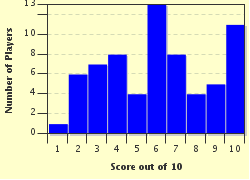Quiz Answer Key and Fun Facts
1. Many people recognize the Big Dipper in the sky. Sometimes people see other groups of stars and mistake them for the Big Dipper. Just to be sure, how many easily visible stars compose the Big Dipper?
2. The rightmost two stars of the Big Dipper are known as, "The Pointers." What do they point to?
3. The Pointers are not the only stars in the Big Dipper that can lead you to locate another major star. The three stars that form the "handle" begin an arc in the sky. What bright, reddish-orange star can you find by following the arc of the handle of the Big Dipper?
4. The left two stars of the bowl of the Big Dipper are also pointer stars. They point to a major star in the opposite direction from Polaris. What star is that?
5. In the Northern Hemisphere, for almost half of each year, we can observe three very bright stars that make up the Summer Triangle. Which of these stars is NOT a member of the Summer Triangle?
6. Most visible around the month of August, the constellation Sagittarius is more commonly recognized by a pattern of eight bright stars that resembles the shape of a household object. What is this asterism called?
7. Orion, the Hunter, is a well-known constellation that appears as an hourglass shape in the sky mainly between November and April. What is the name of the red supergiant star that appears at the upper left of the hourglass that, when spelled as pronounced, was the name of a popular movie?
8. The asterism known as the Winter Hexagon is composed of six bright stars that surround the constellation Orion. Which of these stars is a member of the Winter Hexagon?
9. In addition to the stars, you should enjoy observing the naked eye planets. Which planet cannot be seen with the naked eye?
10. Best visible around November, the constellation Cassiopeia is often recognized as what letter(s) of the alphabet?
Source: Author
Bfree_Freeb
This quiz was reviewed by FunTrivia editor
rossian before going online.
Any errors found in FunTrivia content are routinely corrected through our feedback system.

